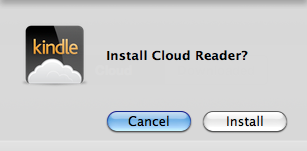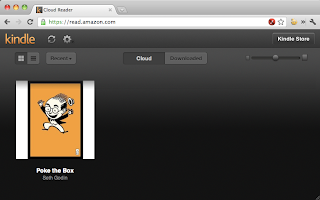In the last few hours Amazon announced their “Cloud Reader”, enabling you to read your Kindle collection from a browser. Sounds great, but what’s the implementation like?
Webkit based means no Firefox
Firstly they’re promoting it as a web-based reader, however with their use of WebSQL database they only support Chrome and Safari. Attempting to use the service using the FireFox 8 Nightly builds results in the message “Your web browser isn’t supported yet. Download Chrome or Safari below.”.
Initially I was surprised they didn’t use an abstraction layer allowing them to support IndexDB (Firefox IE) and WebSQL (Webkit). From reading articles, it looks like their target market is tablet devices meaning Webkit based browsers, making supporting only WebSQL an obvious choice. This is an important point for developers – understand your user-base when developing products. Release a product that works for your target audience, only add additional time and complexity if there is demand.
When I jumped into the product, there were a few more interesting surprises. I was shown was an option to setup Offline Reading. From a users point of view this was very surprising – most people would assume offline reading would be enabled by default.
Instead, it expects me to install a Chrome Extension. Amazon knows they will always have HTML5 and WebSQL available so I’m guessing this allows them to get around DNS lookups when no wi-fi is found.

Sadly, after clicking Install I was shown a blank tab with no explanations and nothing listed under my browser extensions. Not a great experience. I do have an Amazon Reader WebApp icon, however this process feels confusing and unnecessary mainly because of the time within the journey they asked me but also the lack of indication from Chrome about if it’s an App or Extension.
Explicit Offline Mode
Within the reader the offline mode becomes even more confusing. They have made a separation between Cloud and Downloaded which makes sense with a large library but if your currently reading a book is that classed as cloud based or downloaded? From what I could tell it was cloud based which could become annoying. Having the separation of Cloud vs Available Offline would have made more sense based on other terms and phasing used in the application.
However, the reader is impressive. It shows how HTML5 and Javascript based applications can create compelling experiences, reaching beyond the web browser.
Yet, with functionality such as reading preferences not being used across different browsersdevices the reader still has a long way to go.
No wifi but still works
As proof of the potential, what actually happens when you don’t have wifi? The first attempt was a complete failure.
After closing and reopening browsers it worked as expected and I was shown my offline book which was pretty impressive.
This is the start of an interesting future for HTML5 readers with fellow Springboard team Publification creating BrowserBooks which works without having to download extensions and where offline reading is implicit – just like you would have expected.